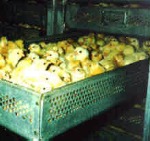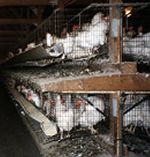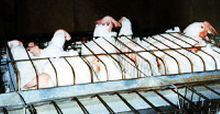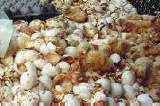

Animal Agriculture
Introduction: The Fall of the Traditional Farm
To many people, the production of meat, eggs, and dairy still evokes images of traditional, idyllic farm settings where animals are treated humanely while alive. In reality, over the past few decades these farms have been almost entirely supplanted by intensive factory-style farms. Why? Increasing market demand for inexpensive animal products has forced agribusiness into a mode where production efficiency is paramount. Factory farms are high-production, largely mechanized indoor settings where animals are heavily crowded and routinely treated in an inhumane manner. A number of abusive practices are common, such as unanesthetized mutilations, excessive subtherapeutic drug use, and withholding food and water to regulate biological cycles or during transport (Fraser & Broom 1990; Mason & Singer 1990; Fox 1984). Furthermore, many animals live virtually their entire lives in cages or stalls which restrict them from even turning around. The current treatment of animals as nothing more than biomachines for food production is resulting in enormous animal welfare problems.
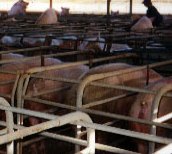
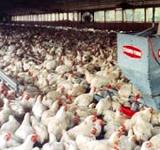
Poultry & Egg Production:
Currently, nearly all chickens, turkeys, and egg-laying hens are raised under intensive methods. Unless specifically advertised as “free range” or “cage-free,” essentially all supermarket and restaurant poultry and eggs (and any foods which contain them) are products of factory farming.
So-called “broiler chickens,” the chickens raised for their meat, are raised by the tens or hundreds of thousands indoors in warehouse-like buildings with automatic feeding equipment. Typically, each bird is given only half a square foot of floor space (Farm Sanctuary 1998; Coats 1989). To prevent the birds from pecking at each other under such stressful conditions, a portion of their sensitive beaks is burned off without anesthesia by a hot blade. Behavioral and anatomical studies of this debeaking process show that it results in prolonged painful effects (Fraser & Broom 1990). After six to seven weeks, broiler chickens are transported to the slaughterhouse in tightly stacked crates. They are given no food or water during the journey or before slaughter. In the slaughterhouse, the chickens are secured upside-down by their feet on a moving rail. They are largely immobilized by an electrified bath, then their throats are slit by a mechanical blade, and finally they are submerged in a scalding tank, sometimes still conscious while boiled. Turkeys are raised and slaughtered similarly, though in addition to debeaking they often undergo unanesthetized toe clipping to reduce any damage due to fighting under the stressful environment.
The plight of birds associated with egg laying begins at the hatchery. Since males cannot lay eggs, half of all newborn chicks are soon eliminated by suffocation, grinding alive, or by simply discarding them in trash cans. Females quickly grow to become egg layers. For virtually their entire lives, egg-laying hens are confined to small wire cages stacked in layers. Usually four or five debeaked hens are fit so tightly per cage that the birds eventually lose the majority of their feathers due to unavoidable rubbing against the cage wires. Egg-layers suffer even greater stresses than their broiler cousins because they are not given room to move about or even stretch their wings. A hens’ toes often become entangled in, or even grow around the cage wires, resulting in starvation when access to the food and water just inches away becomes impossible (Mason & Singer 1990; Coats 1989). After roughly a year, hens reach the end of their initial egg laying cycle, at which time they are often slaughtered for low-grade meat.
Fortunately, there are replacements for eggs in baking, in "egg" salad, and even in omelets.
